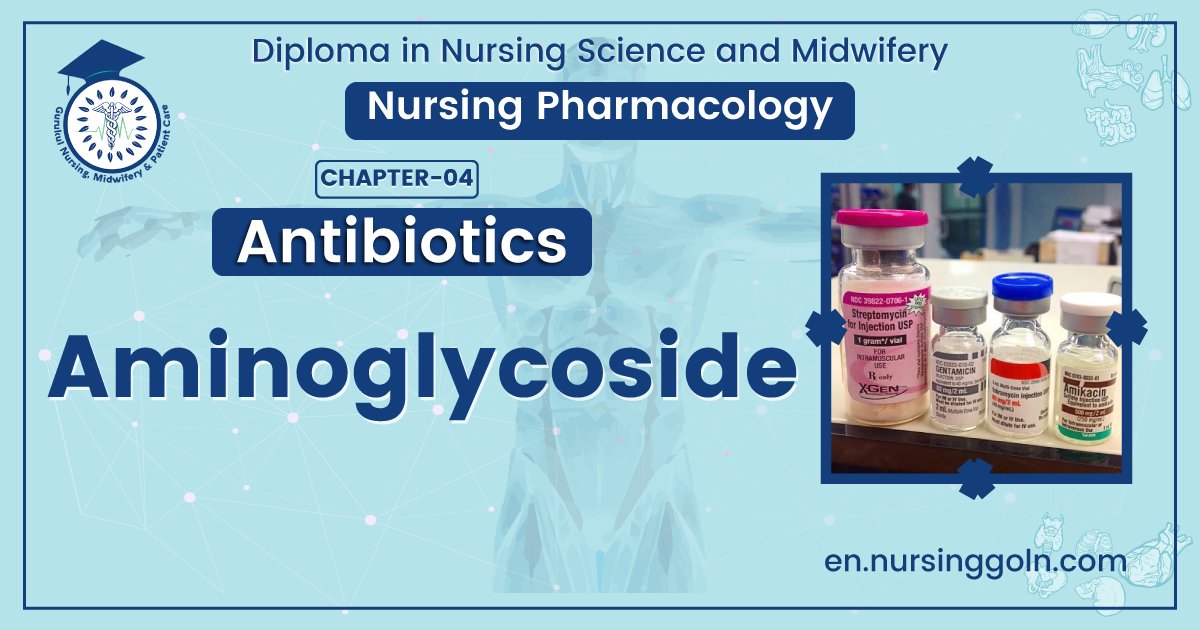Concept of Aminoglycoside – This book covers the entire syllabus of “Pharmacology” prescribed by BNMC- for a diploma in nursing science & midwifery students. We tried to accommodate the latest information and topics. This book is an examination set up according to the teachers’ lectures and examination questions.
At the end of the book, previous questions are given. We hope in touch with the book students’ knowledge will be upgraded and flourish. The unique way of presentation may make your reading of the book a pleasurable experience.

Concept of Aminoglycoside
The term “aminoglycoside” stems from their structure-two amino sugars joined by a glycosidic linkage to a central hexose nucleus. Aminoglycosides are derived from either Streptomyces sp. (have mycin suffixes) or Micromonospora sp. (end in -micin).
Common properties of Aminoglycosides:
1. All are used as sulphate salts, which are highly water soluble; solutions are stable for months.
2. They ionised in solution; are not absorbed orally; distributed only extracellularly; do not penetrate the brain or CSF.
3. All are excreted unchanged in urine by glomerular filtration.
4. All are bactericidal and more active in alkaline Ph.
5. They act by interfering with bacterial protein synthesis.
6. All are active primarily against gram negative bacilli but spectrum differs.
7. There is only partial cross-resistance among them: an organism resistance to one aminoglycoside may still respond to another.
8. They have relatively narrow therapeutic index.
9. All exhibit common toxicities (ototoxicity, nephrotoxicity, neurotoxicity).
Important aminoglycosides
A. Systemically used aminoglycosides
1. Gentamicin
2. Amikacin
3. Streptomycin
4. Tobramycin
5. Neomycin
6. Kanamycin
B. Topically used aminoglycosides
1. Neomycin
2. Paromomycin
3. Framycetin
Antibacterial spectrum
The aminoglycosides are effective for the majority of aerobic gram negative bacilli, including those that may be multidrug resistant, such as Pseudomonas aeruginosa, Klebsiella pneumoniae, and Enterobacter sp.
Additionally, aminoglycosides are often combined with a B-lactam antibiotic to employ a synergistic effect, particularly in the treatment of Enterococcus faecalis and Enterococcus faecium infective endocarditis. Some therapeutic applications of four commonly used aminoglycosides-amikacin [am-i- KAY-sin], gentamicin [jen-ta-MYE-sin], tobramycin [toe-bra-MYE-sin], and streptomycin [strep-toe- MYE-sin].
Mechanism of action
Aminoglycosides diffuse through porin channels in the outer membrane of susceptible organisms
↓
Inside the cell, they bind the 30S ribosomal subunit
↓
they interfere with assembly of the functional ribosomal apparatus
↓
cause the 30S subunit of the completed ribosome to misread the genetic code
↓
Interfere with the ‘initiation complex’ of peptide formation
↓
Misreading of the code on the mRNA.
↓
Causes a break-up of polysomes into nonfunctional monosomes.
↓
Production of defective bacterial protein (irreversible inhibition of protein synthesis)
↓
Bactericidal action
Indications of aminoglycosides:
1. Gram negative bacillary infections
2. Septicaemia (gentimicin, amikacin)
3. Abdominal and pelvic sepsis.
4. Bacterial endocarditis (gentamicin + penicillin)
5. Tuberculosis, plague, brucellosis.
6. Topical uses (neomycin, framycetin)
7. Conjunctival infection. 8. Infections of external ear.
9. Prior to bowel surgery (to reduce intestinal flora)

Adverse effects
1. Ototoxicity: Ototoxicity (vestibular and auditory) is directly related to high peak plasma levels and the duration of treatment. The antibiotic accumulates in the endolymph and perilymph of the inner ear. Deafness may be irreversible and has been known to affect developing fetuses. Patients simultaneously receiving concomitant ototoxic drugs, such as cisplatin or loop diuretics, are particularly at risk. Vertigo (especially in patients receiving streptomycin) may also occur.
2. Nephrotoxicity: Retention of the aminoglycosides by the proximal tubular cells isrupts calcium- mediated transport processes. This results in kidney damage ranging.. mild, reversible renal impairment to severe, potentially irreversible, acute tubular necrosis.
3. Neuromuscular paralysis: This adverse effect is associated with a rapid increase in concentrations (for example, high doses infused over a short period.) or concurrent administration with neuromuscular blockers. Patients with myasthenia gravis are particularly at risk. Prompt administration of calcium gluconate or neostigmine can reverse the block that causes neuromuscular paralysis.
4. Allergic reactions: Contact dermatitis is a common reaction to topically applied neomycin.

Drug interactions:
Aminoglycosides + loop diuretics: Pharmacological potentiation occurs (i.e. both drugs are ototoxic), so increase the risk of ototoxicity.
Mechanism of inhibition of antimicrobial protein synthesis
mRNA + 30S ribosome (codon)
↓
tRNA carrying polypeptide chain contains anticodon (1)
↓
Codon: Anticodon recognition (2)
↓
Transpeptidation (transfer of polypeptide chain from one tRNA to other, so elongation of chain occurs) (3)
↓
Translocation of tRNA leaving the new site free for next tRNA. (4)
| 1 | Tetracyclines | Compete with tRNA to bind with codon |
| 2 | Aminoglycosides | Cause abnormal codon: anti-codon recognition; so misreading of mRNA and defective protein synthesis occur. |
| 3 | Chloramphenicol | Inhibits transpeptidation. |
| 4 | Erythromycins | Inhibit translocation |
Read more:
